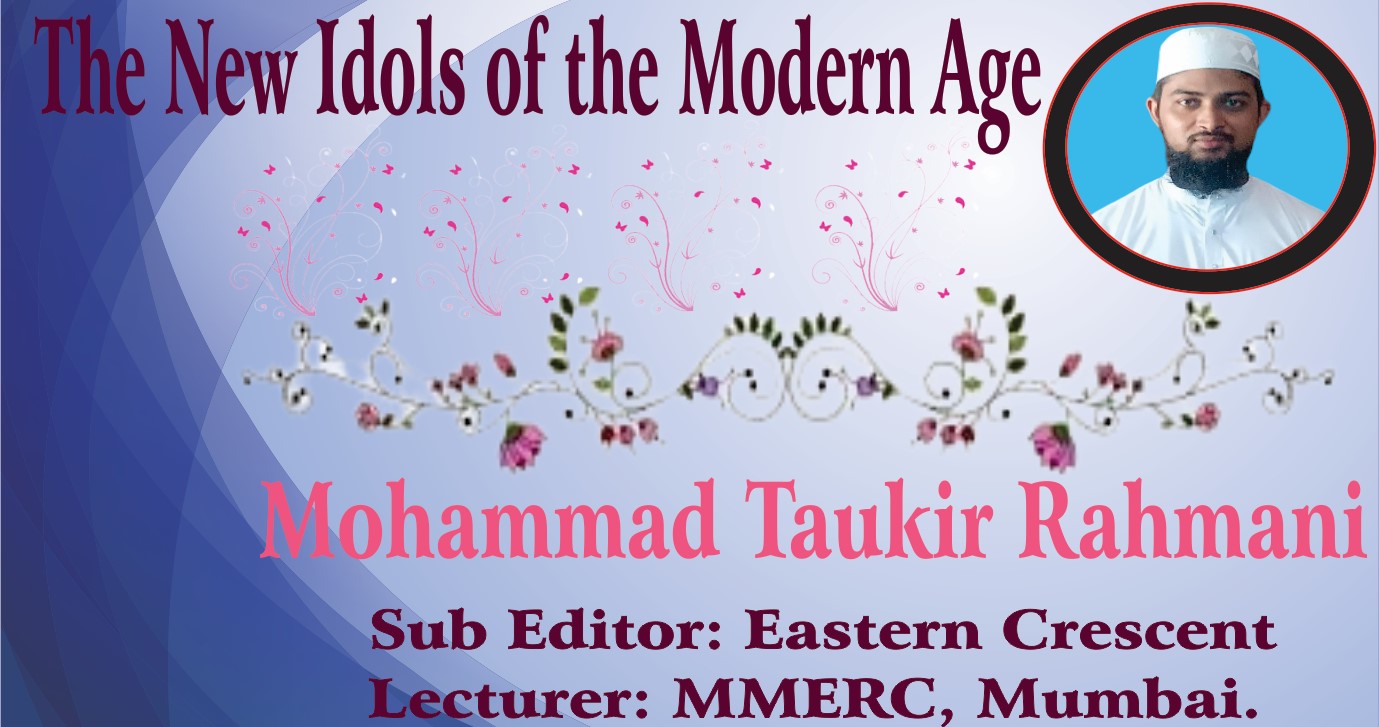The New Idols of the Modern Age
By: Mohammad Taukir Rahmani
Subeditor: Eastern Crescent
The passage of time is marked by perpetual change, a truth universally acknowledged by human reason. As Iqbal observed, “Permanence belongs only to change in the world of time.” Yet, much of this change is superficial, manifesting primarily in names, appearances, and outward forms, while the essence of ideas, the tendencies of human nature, and the inner architecture of belief remain largely constant. They merely clothe themselves in new attire to reappear in subsequent ages.
History testifies that while inventions and discoveries have propelled the material dimension of civilization forward, it is ideologies and systems of thought that have defined the spiritual direction of entire nations. Limiting the notion of change to the alteration of external forms alone is to fall prey to a subtle intellectual deception—a deception that blinds perception to the fact that the essence of ancient shirk (polytheism) remains embedded in today’s culture, politics, and economics, often in forms more active and insidious than in antiquity.
The common imagination, when confronted with the concept of shirk, instinctively pictures the worship of carved idols—objects of stone, clay, or wood—before which human beings bend in reverence. Yet, shirk is not confined to such outward rituals. It is an intellectual deviation, an inner disposition that accepts the attributes of divine lordship (ṣifāt al-rubūbiyyah) as belonging to others besides God. Whether it took the form of Lat and Manāt in pagan Arabia or appears today as ideologies, global systems, and secular “freedoms,” its essential nature is identical: the division of God’s exclusive attributes among others. As the precise formulation of theologians states:
>”تقسیم صفات الربوبیۃ علی غیراللہ“
—the partition of the attributes of Lordship among other-than-God.
In ancient pagan systems, shirk was not a single religious act but a comprehensive worldview. Among the Arabs, Lat was regarded as the goddess of sustenance, while in Hinduism, Lakshmi occupies the same role. Power, honour, and dominion were vested in al-‘Uzzā in Arabia, and in Kālī or Hanuman in the Hindu pantheon. Rain, fertility, and agricultural abundance were linked to Hubal for the Arabs, and to Indra or Varuna in Hinduism. Knowledge and learning were sought from Suwaʿ in Arabia and from Saraswati in India. Death, fate, and the afterlife were determined by Manāt for the Arabs and Shani or Yamraj for Hindus. Even salvation and deliverance—concepts exclusive to God in the theology of tawḥīd—were attributed to deities like Krishna and Vishnu.

The unifying principle in all these cases is the same: attributes that belong solely to the Creator were distributed among multiple entities, each embodying a fragment of divine power. This “fragmentation of divinity” is the spiritual DNA of shirk, and it survives every change of costume. The idols of stone may be gone, but the ideological idols of the modern world operate with equal, if not greater, influence.
Modern Equivalents of Ancient Idols
1. Provision and Sustenance
In pagan Arabia, Lat was invoked for wealth; in Hinduism, Lakshmi still symbolises prosperity. Today, the providers have new names: multinational corporations, the global market, state welfare systems, and financial institutions. When dependence shifts entirely to these structures—when the loss of a job, the collapse of a market, or a change of government is imagined to sever the lifeline of sustenance—then the creed “Allah is the Provider, the Possessor of firm strength” is replaced in practice by a modern form of Lat.
2. Power and Defence
The role of al-‘Uzzā in Arabia and Kālī or Hanuman in India was to inspire trust in military might. In the contemporary order, similar trust is placed in superpowers, defence alliances, and nuclear arsenals. Nations often behave as if displeasing Washington, NATO, or other military blocs would result in immediate ruin—precisely the kind of reverence once accorded to martial deities.
3. Agriculture, Rain, and Resources
Where once Hubal or Indra were seen as controllers of rain and fertility, the role is now played by technological monopolies and international research institutions. The belief that the absence of imported seeds or the withholding of foreign technology will destroy agricultural capacity is essentially the reappearance of Hubal, wearing the attire of science.
4. Destiny, Law, and Judgement
In ancient belief, Manāt or Shani governed fate and decreed outcomes. Today, such authority is assigned to the United Nations, constitutional courts, and legislative assemblies. The principle “The people’s will is the ultimate law” or “The constitution is the supreme authority” stands in direct opposition to the Qur’anic axiom: “The command belongs to none but Allah.”
5. Knowledge, Guidance, and Enlightenment
Suwaʿ or Saraswati were invoked for wisdom; now, global media conglomerates, secular academia, and cultural influencers define truth and falsehood, virtue and vice. When moral and intellectual authority is surrendered to human institutions in defiance of divine guidance, the essence of shirk is realized, even if no physical idol exists.
6. Freedom, Salvation, and Liberation
Ancient systems exalted Vishnu or Krishna as liberators; modern ideologies sanctify “human rights,” “freedom of expression,” and “my life, my choice” as ultimate ideals. This is the enthronement of desire as deity—the phenomenon the Qur’an describes: “Have you seen the one who takes his desire as his god?”
7. Equality and the Promise of Paradise
The salvific role of ancient gods has been adopted by ideologies like communism and absolute egalitarianism, which promise a man-made utopia through economic restructuring. The underlying premise—that human design can replace divine decree—remains the same hubris that animated the priesthoods of old.
8. The Idol of Nationalism
Patriotism is a noble sentiment and rightfully one of a person’s foremost duties — to love the land where one lives, to protect it, and to contribute to its peace and stability. However, when this sentiment crosses its natural boundaries and steps into the realm of belief and sanctity, it turns into nationalism — elevating the nation to the status of a deity, worshiping it, and justifying every truth and falsehood, every justice and injustice in its name. This is the point where a legitimate love becomes an intellectual disease and a deviation in creed — a form of shirk so detestable that both sound reason and divine revelation reject it.
The Persistent Nature of Shirk
These parallels demonstrate that shirk is not an artefact of the past but a recurring spiritual pathology. The assumption that technological advancement and modern education have eliminated polytheistic tendencies is itself evidence of how deeply shirk has adapted to the modern psyche. Where ancient idols demanded bowing and sacrifice, modern idols demand mental allegiance, ideological loyalty, and existential dependence.
Today, to understand shirk, there is no need to travel to distant lands or ancient civilizations. A deep look into our own country, state, and society reveals both its ancient and modern forms. Sometimes it appears in blind devotion to a political leader or party, sometimes in unconditional dependence on a capitalist or an institution, sometimes in considering the constitution or courts as the ultimate authority, and sometimes in turning certain ideologies or slogans into matters of life and death. All of this proves that while the idols have changed, the spirit of shirk is still alive — it has merely donned new attire.

However, recognizing shirk in its contemporary forms requires intellectual clarity and theological vigilance. The essence of tawḥīd is not merely to acknowledge God as the sole object of worship, but to affirm His exclusive authority as lawgiver, sustainer, owner, saviour, and final judge—and to reject all claims that compete with His sovereignty in any of these domains.
Failure to identify and dismantle the ideological idols of the age ensures their silent reign over thought, culture, and social order. The idols of the twenty-first century may not stand in temples, but they reside in political doctrines, economic theories, cultural norms, and moral philosophies. To resist them is not optional; it is the very demand of faith.















Does your blog have a contact page? I’m having a tough time locating it but, I’d like to send you an e-mail. I’ve got some creative ideas for your blog you might be interested in hearing. Either way, great website and I look forward to seeing it improve over time.
you are in point of fact a excellent webmaster. The website loading velocity is amazing. It sort of feels that you’re doing any unique trick. Furthermore, The contents are masterpiece. you’ve done a great task on this topic!